- Wage garnishment is a legal process where a court order requires an employer to withhold a portion of an employee’s earnings to repay a debt.
- Employers receive a court order, calculate the amount to be withheld, and remit the funds to the creditor until the debt is paid or the order expires.
- Types of garnishment include wage garnishment, bank account garnishment, and tax refund garnishment.
- Creditors, government agencies (like IRS), student loan providers, and courts can garnish wages.
- Up to 25% of disposable income can be garnished, depending on the employee's earnings.
- Employees are protected from termination due to a single garnishment, and limits apply to how much can be garnished.
- Child support garnishments can be up to 60% of wages, and unpaid taxes have different garnishment rules.
Wage garnishment is a legal process in which an employer withholds a portion of an employee's earnings to pay off a debt. The average garnished worker faces this situation for about five months, with roughly 11% of their gross earnings being remitted to creditors.
For employers, managing wage garnishment can be a complex process. As part of compliance, they must ensure accurate calculations and timely remittance, all while protecting the rights of their employees.
In this blog, we delve into the complex process of wage garnishment and the crucial protections afforded to employees.
What is Wage Garnishment?
Wage garnishment is a legal procedure where a court order mandates an employer to withhold a portion of an employee's earnings. This withheld money is then directly sent to a creditor to repay a debt.
Common reasons for garnishment include unpaid taxes, monetary fines, child support payments, and defaulted student loans. The employer, known as the garnishee, plays a crucial role in this process.
How does Wage Garnishment work?
A court order is generally required for wage garnishment, except in cases involving an IRS levy, where no court order is needed. For instance, if Jane Doe owes $8,500 in back taxes, the IRS can directly garnish her wages without a court order.
When a garnishment order arrives, it triggers a series of responsibilities for your organization.
- Receiving the Order: You will typically receive a formal court order or government agency directive (e.g., IRS levy) requiring you to garnish an employee's wages. It includes the employee’s name, total debt, debt type, withholding amount, and payment instructions.
- Actioning the Withholding: Upon receiving the order, you must withhold a portion of the employee's disposable earnings.
- Notifying the Employee: While not always legally required, it's best to inform the employee about the garnishment in writing, including a copy of the order and an explanation of deductions.
- Calculating the Amount: Accurately calculate the amount to withhold, considering federal and state limits on garnishment, and ensuring it aligns with the order.
- Remitting Funds: Remit the garnished funds to the designated creditor or agency by the specified deadlines, either via check or electronic payment.
- Ongoing Management: The garnishment continues until the debt is paid, the order expires, or you receive a notice to stop.
Pro Tip: Keep careful records of all communications, calculations, and payments for compliance and audits.
Properly managing the garnishment process ensures compliance and minimizes risks for your organization.
Now let's explore the different forms of garnishments.
Different Forms of Garnishment
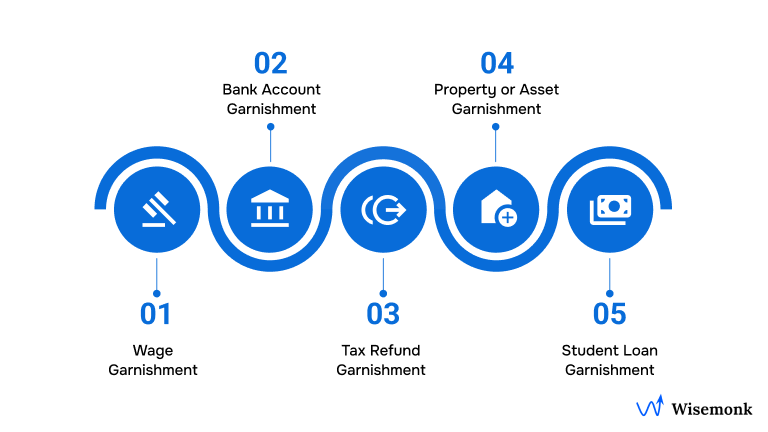
"Garnishment" isn't limited to just wages. While wage garnishment directly impacts payroll, other forms of garnishment can affect your employees' financial well-being and might, in some cases, indirectly involve your company (e.g., through inquiries or employee stress).
Here are the primary types of garnishment:
1. Wage Garnishment:
Wage garnishment is the most common type for employers. It involves a court order or government directive requiring you to deduct a specific portion of an employee's earnings and send it directly to a creditor.
- Limits on Deduction: Federal and state laws set caps on how much of an employee’s "disposable income" can be garnished.
- Minimum Retained Earnings: Employees must retain a minimum amount of income to cover basic living expenses.
2. Bank Account Garnishment (Bank Levy)
In a bank account garnishment, a creditor obtains a court order to seize funds directly from an individual’s bank account. Once the bank receives the levy, it typically freezes the account up to the amount owed.
- Frozen Funds: The bank freezes the employee’s funds up to the amount specified in the court order.
- Employer Indirect Involvement: While not directly involved, employees may seek your assistance if a bank levy impacts their paychecks.
3. Tax Refund Garnishment
Government agencies, like the IRS or state tax authorities, can intercept an individual’s tax refund to cover unpaid taxes or other government-related debts.
- Government Action: The IRS or state tax authorities notify the employee about the intention to garnish their tax refund.
- No Payroll Involvement: This type of garnishment does not directly impact your company’s payroll process.
4. Property or Asset Garnishment
In a property or asset garnishment, a creditor can seize physical assets or property to settle unpaid debts. This typically occurs after a court order, where the creditor identifies valuable property that can be sold to cover the debt.
- Seizure of Property: Creditors can take ownership of valuable items or assets, such as vehicles or real estate, to settle the debt.
- Court Order Required: A court order is necessary to initiate this type of garnishment.
- Indirect Impact on Employers: While employers aren't directly involved, employees may face financial strain or need assistance if their assets are seized.
5. Student Loan Garnishment
When an employee defaults on federal student loans, the government can garnish their wages to recover the unpaid debt. This type of garnishment typically occurs after a series of missed payments and attempts to collect the debt.
- Federal Student Loan Defaults: The government can garnish wages without a court order if federal student loans are in default.
- Wage Withholding: A portion of the employee’s wages is deducted directly by the employer to repay the student loan debt.
- Notice Requirements: Employees are notified in advance of garnishment, with the opportunity to resolve the debt before deductions are made.
Entities Authorized to Garnish Wages
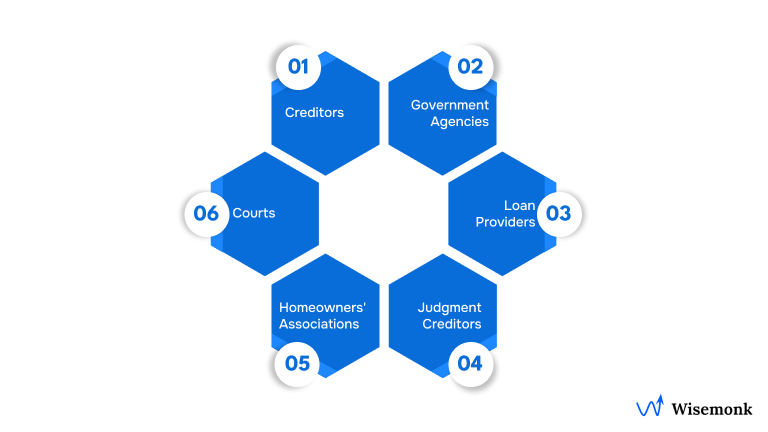
Several entities have the legal authority to initiate wage garnishment. Understanding who can issue a garnishment order is essential to ensure the proper procedures are followed and legal compliance is maintained.
While not an exhaustive list, here are the common entities that can garnish wages:
- Creditors: Companies or individuals to whom an employee owes money (e.g., credit card companies, medical providers) can obtain a court order to garnish wages if the employee defaults on payments.
- Government Agencies: Federal, state, and local tax authorities (like the IRS) frequently garnish wages for unpaid taxes. This category also includes agencies enforcing child support obligations.
- Student Loan Providers: If an employee defaults on federal or private student loans, the loan servicer or collection agency may secure a court order for wage garnishment.
- Judgment Creditors: Any individual or business that has obtained a court judgment against an employee for a debt can legally pursue wage garnishment to collect the awarded amount.
- Homeowners' Associations (HOAs): In certain states, HOAs can obtain judgments and subsequently garnish wages for unpaid fees or assessments related to property maintenance or dues.
- Courts: Courts themselves can issue wage garnishment orders to collect unpaid fines, court costs, or restitution resulting from various legal proceedings, such as traffic violations or criminal convictions.
What Percentage of an Employee’s Wages Can be Garnished?
Under Title III of the Consumer Credit Protection Act, there are specific limits on how much of an employee’s wages can be garnished. The percentage varies based on the type of garnishment, with different rules for ordinary garnishments versus child support and alimony.
- Ordinary Garnishments: Employers can garnish the lesser of:
- 25% of disposable earnings, or
- The amount by which disposable earnings exceed 30 times the federal minimum wage.
- Child Support and Alimony: Employers can garnish up to:
Example Scenario
Let’s assume an employee earns $600 per week in disposable income, and the federal minimum wage is $7.25 per hour.
- 25% of Disposable Earnings:
25% of $600 = $150 - 30 Times the Federal Minimum Wage:
30 x $7.25 = $217.50
Disposable earnings exceeding $217.50 = $600 - $217.50 = $382.50
The garnishment would be the lesser of the two amounts, so $150 would be garnished from the employee’s wages.
However, if this employee were subject to child support or alimony, the garnishment amount could be higher, depending on their specific circumstances.
Special Considerations
Under Title III of the Consumer Credit Protection Act (CCPA), certain types of debts are exempt from the standard wage garnishment limits. Specifically, the restrictions on the amount of an individual's earnings that may be garnished do not apply to:
- Bankruptcy Court Orders: Garnishments issued under the laws governing bankruptcy proceedings are not subject to the CCPA's limitations.
- Voluntary Wage Assignments: Situations where employees voluntarily agree to have a portion of their earnings withheld to pay a debt are not considered wage garnishments under the CCPA.
It's essential to note that, although these exceptions exist, other laws and regulations may impose their restrictions or requirements regarding these types of garnishments.
By adhering to these rules, employers ensure that they comply with federal and state wage garnishment regulations while balancing the need to address debts owed. Now, let’s explore the garnishment rules by federal law.
Garnishment Rules by Federal Law
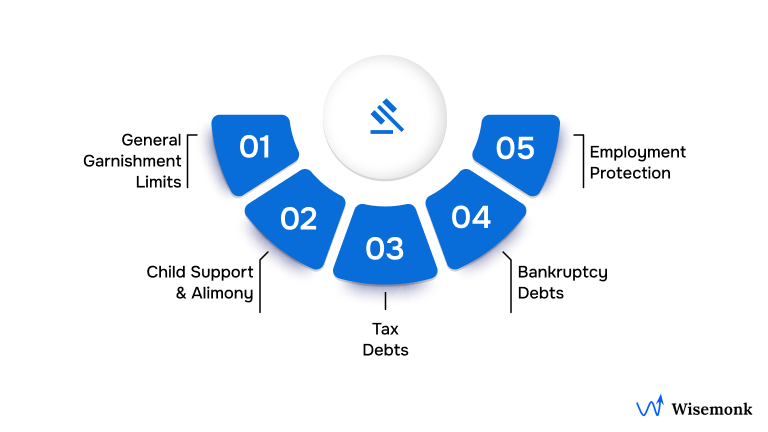
Under Title III of the Consumer Credit Protection Act (CCPA), federal law sets specific guidelines for wage garnishment to protect employees' earnings.
Key Provisions:
- General Garnishment Limits: The lesser of 25% of disposable earnings or the amount by which disposable earnings exceed 30 times the federal minimum wage ($7.25/hour) can be garnished for consumer debts.
- Child Support and Alimony: Up to 50% of disposable earnings may be garnished if the employee supports another spouse or child; up to 60% if not. An additional 5% may be garnished if payments are more than 12 weeks in arrears.
- Tax Debts: Garnishment limits do not apply to unpaid federal or state taxes. Federal agencies can garnish up to 15% of disposable earnings for tax debts.
- Bankruptcy Debts: Garnishment limits do not apply to debts resulting from bankruptcy court orders.
- Employment Protection: Employers are prohibited from discharging an employee whose earnings have been garnished for any one debt.
These federal guidelines ensure a balance between creditors' rights and employees' financial protection.
Is an Employer Allowed to Refuse Wage Garnishment?
Employers are legally required to comply with wage garnishment orders once received, even if the employee is uncomfortable with it. Garnishments must continue until the debt is paid off, the order expires, or the employer is instructed to stop. Non-compliance can result in legal consequences, including fines or penalties.
How to garnish wages?
Properly managing wage garnishments requires a clear process and adherence to legal guidelines. Employers must ensure compliance with the garnishment order while minimizing errors that can lead to legal complications.
- Respond Promptly: Address the court or agency as per applicable regulations.
- Calculate Accurately: Apply the rules for calculating the garnishment, ensuring the correct base wage is used.
- Timely Withholdings: Deduct the appropriate amount from each paycheck as mandated by law.
- Handle Multiple Garnishments: Process them in the correct order of priority if multiple garnishments exist.
- Avoid Errors: Prevent administrative mistakes that could result in legal repercussions.
- Communicate Effectively: Address employee concerns and communicate with relevant parties, such as collection agencies or creditors.
Managing wage garnishments effectively ensures compliance and reduces risks for your organization.
Now, let's explore how to handle garnishment orders for independent contractors and employees working overseas.
How do you handle garnishment orders for independent contractors and employees working overseas?
Garnishment rules vary for independent contractors and overseas employees, and compliance depends on the specific legal context and jurisdiction.
Independent Contractors
Independent contractors are not classified as employees, so standard wage garnishment laws do not apply to them. However:
- Child Support: If you receive an Income Withholding Order (IWO) from the Office of Child Support Enforcement, you must comply by withholding child support payments from the contractor's compensation.
- State Laws: Some states, like Virginia, require compliance with garnishment orders for independent contractors, even for consumer debts.
- Legal Advice: It's advisable to consult legal counsel when handling garnishment orders for independent contractors to ensure compliance with applicable laws.
Overseas Employees
When dealing with garnishment orders for employees working abroad:
- Child Support: If the employee is in a country with a reciprocity agreement with the U.S. for child support enforcement, you must comply with the garnishment order.
- Other Debts: Federal law does not require compliance with foreign garnishment orders for debts other than child support.
- Employer of Record (EOR): If employing through an EOR, consult with them to ensure proper handling of garnishment orders.
Always ensure compliance with both federal and state laws when handling garnishment orders for independent contractors and employees working overseas.
Protection for the Employees Facing Wage Garnishment
Federal law, specifically Title III of the Consumer Credit Protection Act (CCPA), offers significant protections to employees facing garnishment.
- The CCPA prohibits employers from discharging an employee whose wages have been garnished for a single debt, regardless of how many levies occur.
- It also sets limits on the amount of an employee's earnings that can be garnished in any given week.
However, these protections do not extend to an employee facing garnishment for a second or subsequent debt.
Conclusion
Wage garnishment is a legal process that impacts both employees and employers, requiring careful understanding of applicable laws and regulations. Employers must comply with garnishment orders and manage the process properly to avoid legal repercussions.
The rules vary for both independent contractors and overseas employees, so seeking legal advice is crucial. Being informed helps both parties navigate garnishment effectively and with minimal hardship.
Managing payroll for overseas employees can be complex, with varying laws and regulations across regions.
Wisemonk offers a seamless solution to ensure compliance and smooth payroll management.
- Payroll Compliance: Ensure accurate payroll processing across multiple countries.
- Automated Tax Calculations: Simplify tax deductions with automated calculations and filings.
Let Wisemonk handle your payroll challenges with ease. Check our pricing and contact us for more information today!
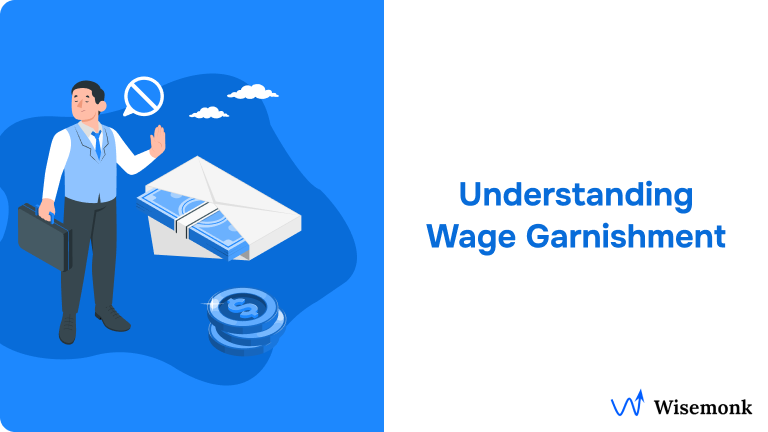




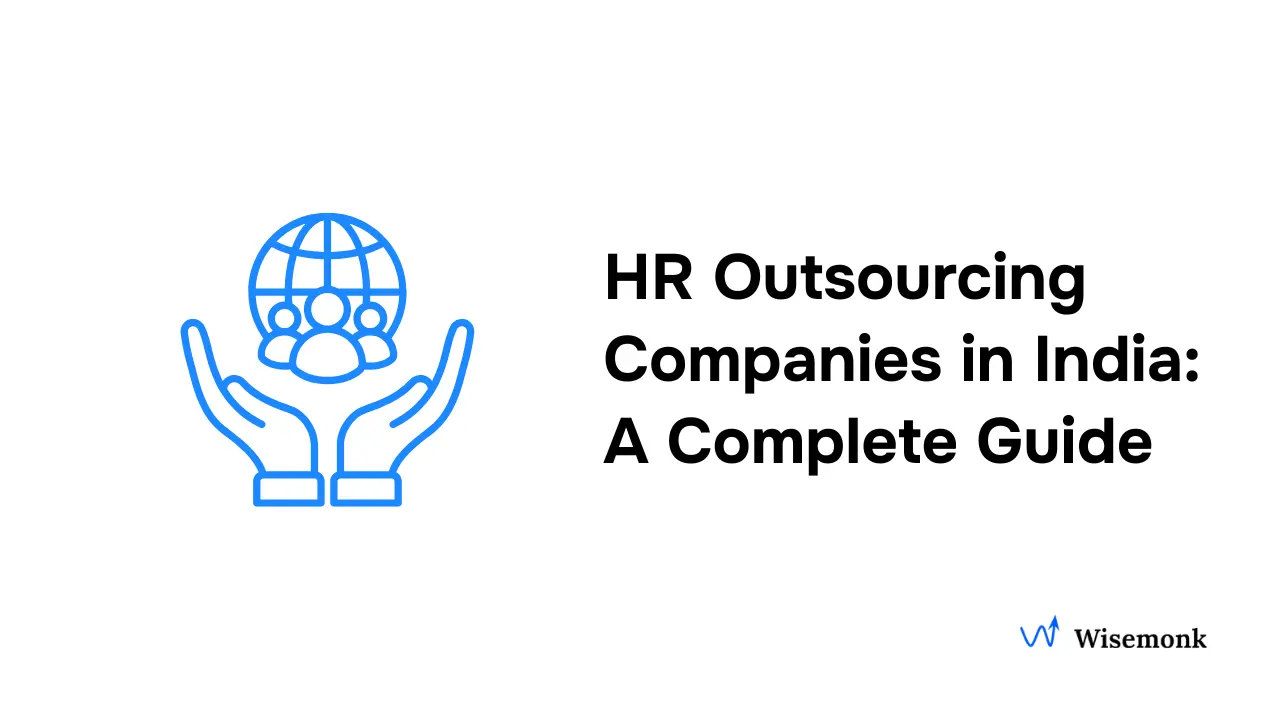
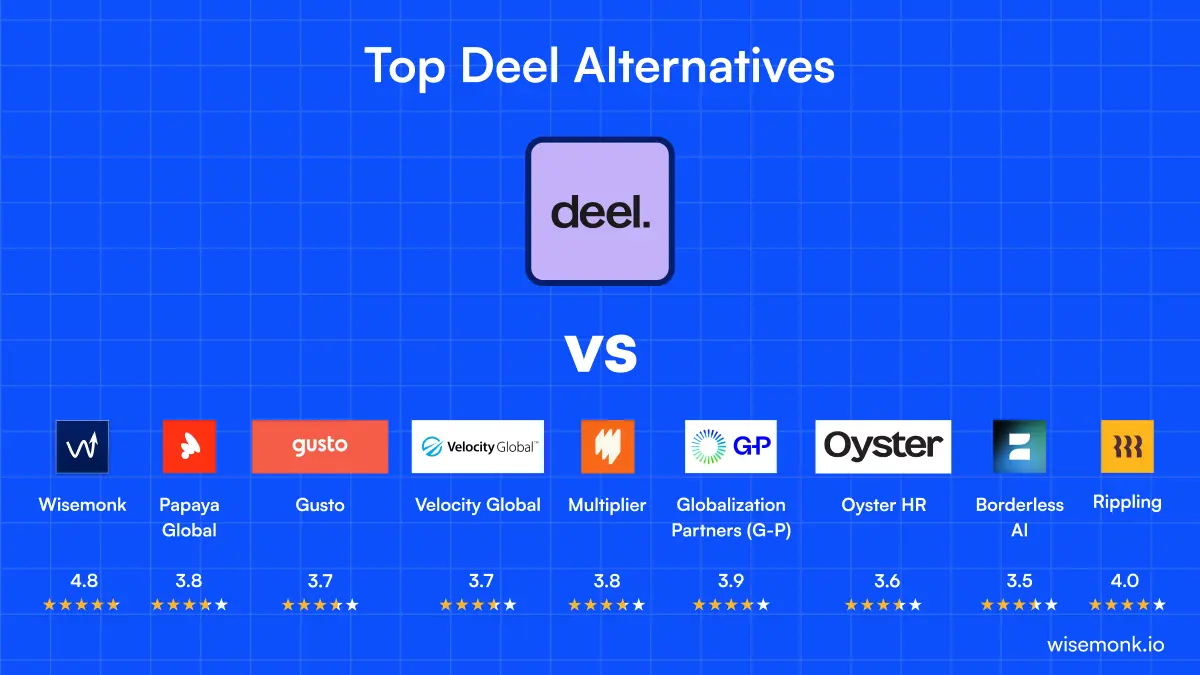
.webp)